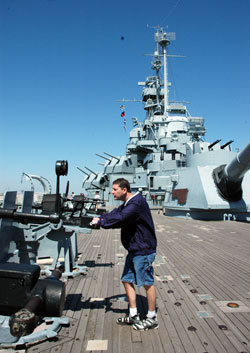Vacation / Travel Supplement
‘The Mighty A’:
USS Alabama is moored at Mobile as naval museum

St. Michael the Archangel parishioner Dan Roth of Plymouth, Ind., in the Fort Wayne-South Bend Diocese, examines a large gun on the deck of the USS Alabama, which is moored along the shore at Mobile, Ala., and serves as a naval museum. His grandfather, Seaman First Class Paul L. Travis, served in the U.S. Navy on board the battleship for three years during World War II. (Photo by Mary Ann Wyand)
By Mary Ann Wyand
MOBILE, Ala.—Return to your roots for a memorable vacation this summer.
Research your family’s history then plan a trip to a city or special location that has personal connections for your parents or grandparents.
My father, Paul L. Travis of Plymouth, Ind., was killed in a work-related accident in northern Indiana when I was only 3 years old, but I have pictures of him in his Navy uniform and several mementos from his three years of military service during World War II.
He served on the USS Alabama in both the Atlantic and Pacific Fleets with the rank of Seaman 1st Class.
The USS Alabama is permanently moored at Battleship Park in Mobile Bay, where it is open to the public with other ships, planes and a submarine at the naval museum.
With several relatives, I toured the massive ship on March 25, 2008, and found the experience to be quite emotional—especially when I saw my father’s name on the list of sailors and Marines who served on “The Mighty A.”
Notes written inside his tattered copy of The Bluejackets Manual 1940 listed his active duty assignments.
Historical accounts of the battleship’s destinations recorded in several books sold in the museum gift shop gave me an even clearer picture of his rigorous life at sea.
I learned that the battleship was launched on Feb. 16, 1942, and commissioned exactly six months later.
The ship served in the North Atlantic until August 1943, when it crossed through the Panama Canal and joined the Pacific Fleet.
Sailors on board the USS Alabama shot down 22 enemy planes as part of both the Atlantic and Pacific Fleets. They also joined in six bombardments of Japanese strongholds, and earned nine battle stars for their ship and the nickname “Hero of the Pacific.”
The ship cruised at 28 knots, or 32 miles an hour, and carried 2,500 men in wartime and 1,785 men in times of peace.
I thought about how my father worked, ate and slept on board the battleship as it sailed on the high seas around the world. It was an honor to tour the ship, and I felt humbled to think that by the grace of God he had made it home safely from the war in which so many brave service men and women gave up their lives for their country.
One of the historical books about the ship featured “remembrances of things past by the men who made her mighty.”
It was nice to read heroic stories preserved for posterity by some of the men who surely knew my father.
(For more information about the
USS Alabama, log on to www.ussalabama.com.) †
